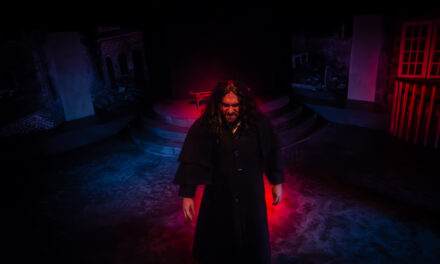OREM — The Frank Capra film It’s a Wonderful Life is an old classic that follows the story of George Bailey, a man of the people in his small town. George is a friend to all he meets, and the kind of everyday hero who often goes unsung. As the show opens and George is contemplating taking his own life after a business tragedy on Christmas Eve, he is visited by his very own guardian angel, Clarence, who shows him the course of his life again. Clarence does his best to convince George that suicide is not the best option in his situation. As the audience watches George’s life unfold, there are countless lessons to learn, and memories to cherish. This timeless Christmas favorite has been adapted for the musical stage, with book and lyrics by James W. Rodgers and music by John Higgins, and was brought to life by the cast and crew of SCERA Center for the Arts.
The story of George Bailey has many components and characters, and each was represented in a unique fashion by the large cast. Each of the supporting characters seemed to have an individualized relation to the and George (played by Matthew Nelson). In particular, Deborah Bowman as Mother Bailey, who always had a fun and spirited character. But Bowman shined brightest during her solo piece of “My Boys!”, where she portrayed with simplicity and power the message that she would do anything for her boys, even if she doesn’t always know what it is to be done. Harry Bailey (played by Franklin West), and Mr. Gower (Steve Whitehead) both made distinct impressions in the short time they occupied the stage. West showed a typical fun-loving little brother, while being conscious of maintaining a good relationship with George when he leaves for college. The grief of having lost a loved one is hard to bring to life, but is personified well by Whitehead as Mr. Gower. The scene with young George in the drugstore was emotional and touching, and an excellent portrayal of true grief. Bert and Ernie (played by Christopher D’Argy and David Layton, respectively) were excellent comical relief and had developed relationships with all the other charactesr, which made them able to poke fun at anyone. “The Bailey Blessing” was a particularly lighthearted number, while not sacrificing the musical quality of the piece.
Eric Glissmeyer as Henry Potter was a terror to behold, in the best of ways. If a real life small town could ever have a villain, it would be Henry Potter. The work that Glissmeyer did to make his scene with Nelson fully developed was impressive. The sleaze and temptation of “Easy Living” almost had me up out of my chair singing about how “life should be a bowl of cherries.” The spell cast by Glissmeyer extended beyond George Bailey, and made its way to my seat in the audience as well.
Natalie Merrill as Mary Hatch Bailey was sweet and entertaining. The quirky friendship and then love between her and her husband was enthralling and fun to watch. Most noticeable about her performance were the musical numbers that Merrill was involved in, from the opening number of “Find and Protect Him,” and then on to “Sliver of the Moon” and “Quiet Wishes, Simple Dreams.” Her voice was clear, rich, and carried well even when having technical issues with her microphone. The character she has developed was a delight independent of George, but was enhanced with their story as well.
While a part with low amounts of stage time, the role of Clarence Odbody can be a wonderful addition to the performance, and with Star Hall in the role, it was. Hall added his own quirks to the character, making the role totally his own. “I Want to Fly” is a song that could feel uncomfortable for the actor playing Clarence because the song is all about the things he could do with wings—and he is clearly wingless. The approach taken by Hall was creative and imaginative, making the audience use their own imagination to think of him with wings, and brought to life the desire to fly. As all of his scenes are done solely between himself and George Bailey, a developing relationship is required to be present and strong, or the magic of the play’s moments will fall short. The relationship built between Nelson and Hall was superb, simply because it wasn’t superb. It was clear from both performances that George was not buying the idea of a guardian angel, and Clarence really was on his last chance and willing to do whatever it took to convince George that death was not the best option. The desperation of each man put a needed strain on the relationship.
The role of George Bailey in this production is one that requires a range of skill and dedication to development of character. Nelson portrayed the many different sides of George well as he wove the story. The ambition seen as he winds back the clock to his younger years, and the dejected spirit of a business worn middle aged man are a stark contrast, and one clearly seen in Nelson’s performance. His delivery of lines with good timing and diction was impeccable. Additionally, the wide variety of relationships that George formed through his years in Bedford Falls was a challenge for Nelson because it required him to put a story and a feel to each person that his character interacted with. This was a challenge that Nelson rose to accept.
The set for this production was solid and made minimal changes, asking the audience to use their imagination to set the scene in their minds. The lighting in the first act of the show seemed a little dark, and would have enhanced the show had it lightened up a bit. The use of lighting during certain memory scenes was good, because it showed the change in situation, but the overall feel was a bit dark and shadowed faces in places that could have used light. The highlight of the technical aspect in this show was the live pianist, Andrew Walsh. Walsh played the music for the entire show, save two songs, expertly. His performance and added a touch to the show that would have been gone if it were done with prerecorded music. Walsh was not only a moving set piece with his upright piano on a wheeled platform, but, in small moments, even a character in the show itself. Having the piano on stage could have gotten in the way, but the choice of director Michael Carrasco to have the piano be mobile and included in the show enhanced the experience.
This entertaining Christmas classic is brought to life in a way that is enthralling. If you are looking for a fun Christmas activity for the family, or a date night, the SCERA Center for the Arts has put together a show worth stepping into.








